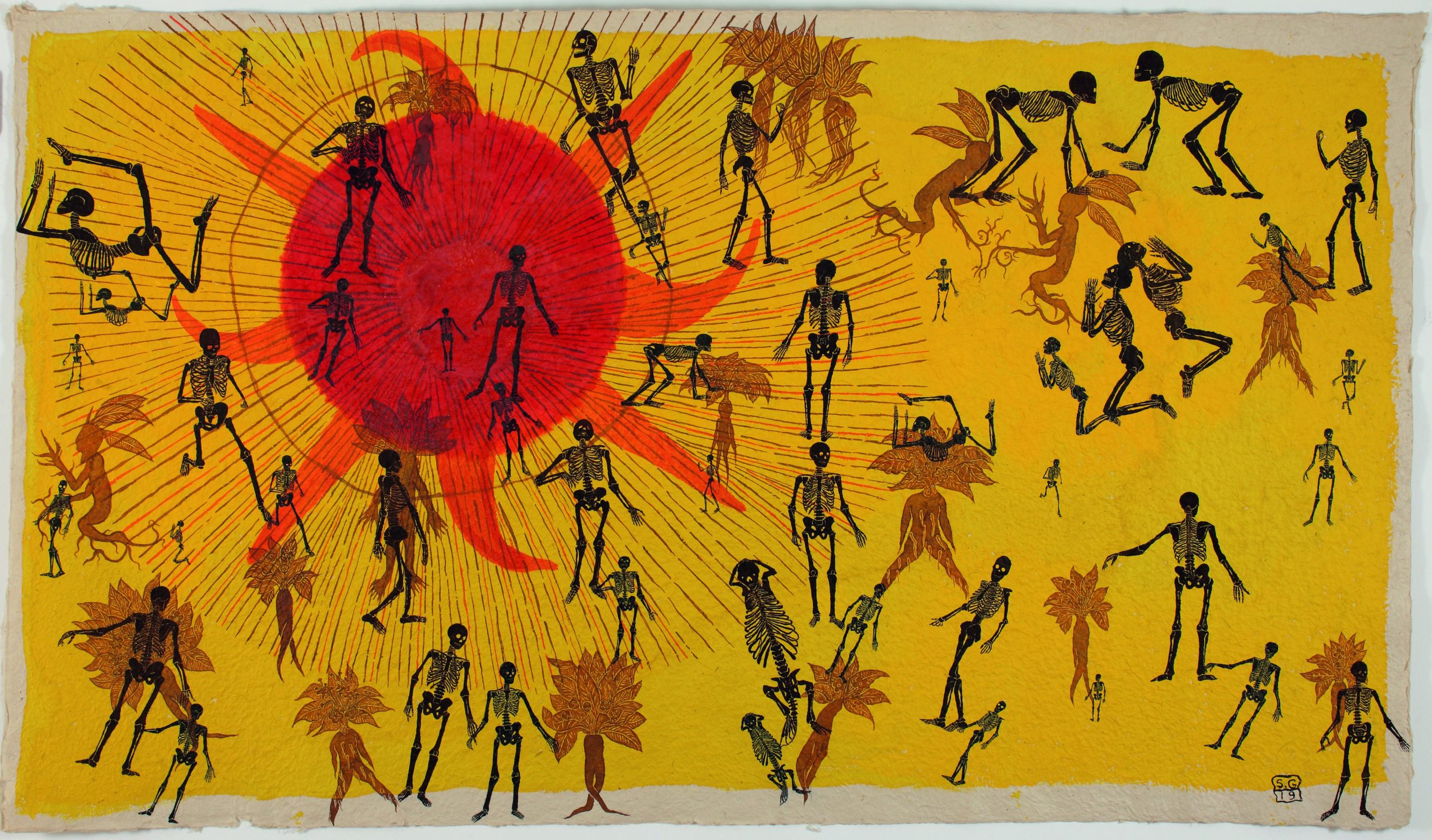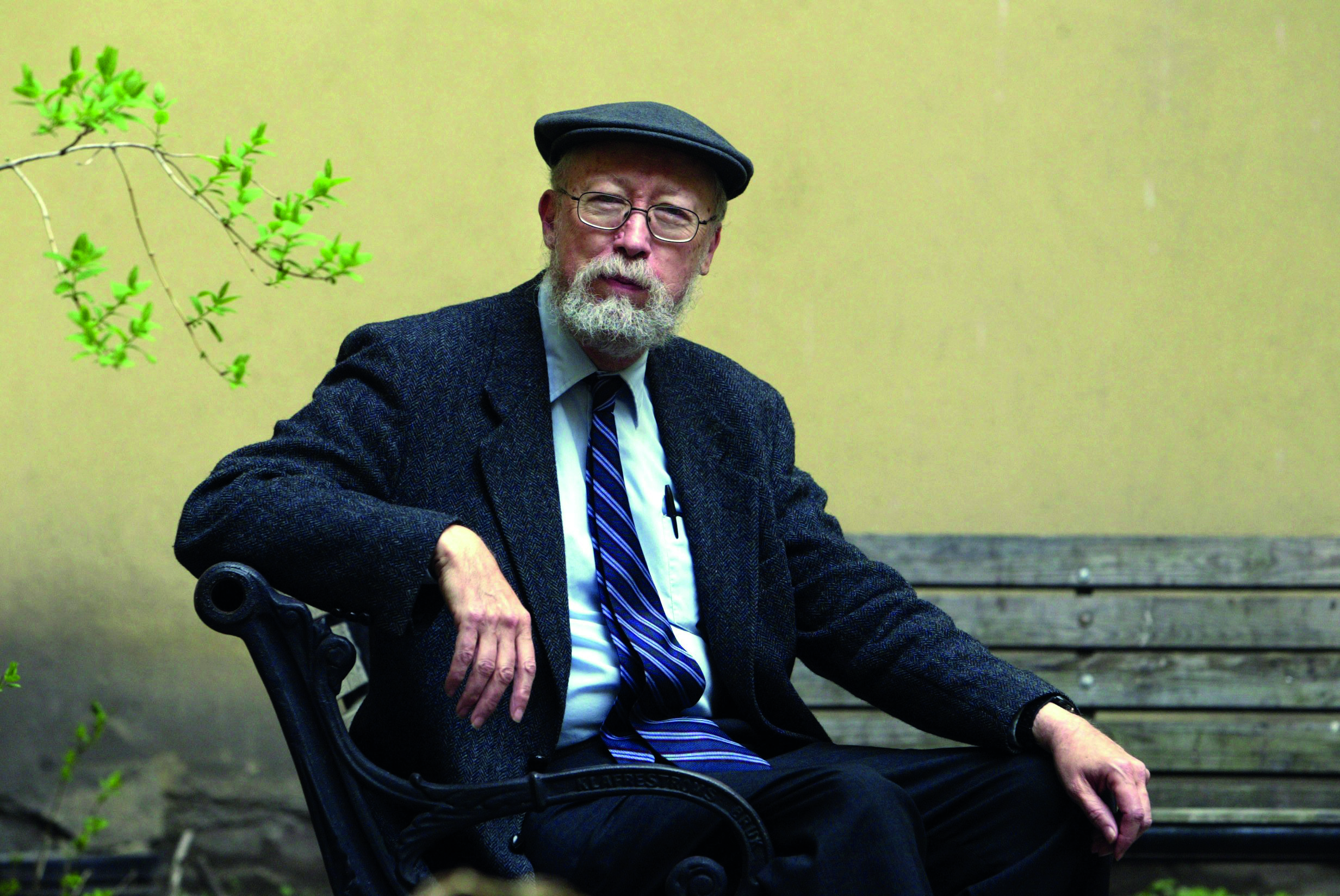“Intersecting lives of the human and animal, their otherworldly genderless figures, human-animal hybrid beings, silently haunt the viewer, bewitching them as if it were a spell.” These are the words on the paintings of Selma Gürbüz. Her 35-year oeuvre, which encompasses themes such as history, tradition, mythology, nature and the subconscious has opened to audiences at Istanbul Modern. The exhibition showcases more than a hundred works by Selma Gürbüz, in which she utilizes various tools of expression such as painting, installation, drawing, video and sculpture.
-
You state that: “For me, each exhibition is a reckoning. It is a new idea, a new feeling within me”. What has been your reckoning with this exhibit? What are the sentiments you have found?
In this exhibition, I wanted to emphasize the relationship I have established with nature and earth. The world has become unbearable. It frightens me that we are preparing our demise with our own hands by destroying the nature that we do not own to begin with. We do not only determine our own fate; we are also shattering natural states that are millions of years old, the ecological balance that creates life on earth, its animals and plants. Although I had no intention of drawing attention to the danger, really. I try to escape from the city as much as I can and take shelter in nature, to dream in that nature, to strengthen my bond with it, to discover animals. I try to feel that I am a part of them, to embrace what I see, and to live my feelings to the fullest.
My World
-
Digital works you have created for the first time are coming together with work from different periods of your artistic career. What do you see when you take a holistic look at the more than 100 works that are gathered together at this exhibit?
By saying, “This Place We Call World”, I’m also speaking about my world. With its nature, animals, plants, women, feelings, thoughts, myths, tales, dreams; it is the world that I am seeing and hearing with many other aspects. That which I breathe in, feel at the depths of my heart and that I have portrayed ceaselessly to this very day.
I look at that world from a distance, with an intense sensuality. There’s a little bit of compassion, sorrow, love and melancholy, as if looking from another planet. At the same time I see it with a story-like, dream-like tone that may cause feelings of alienation and strangeness.
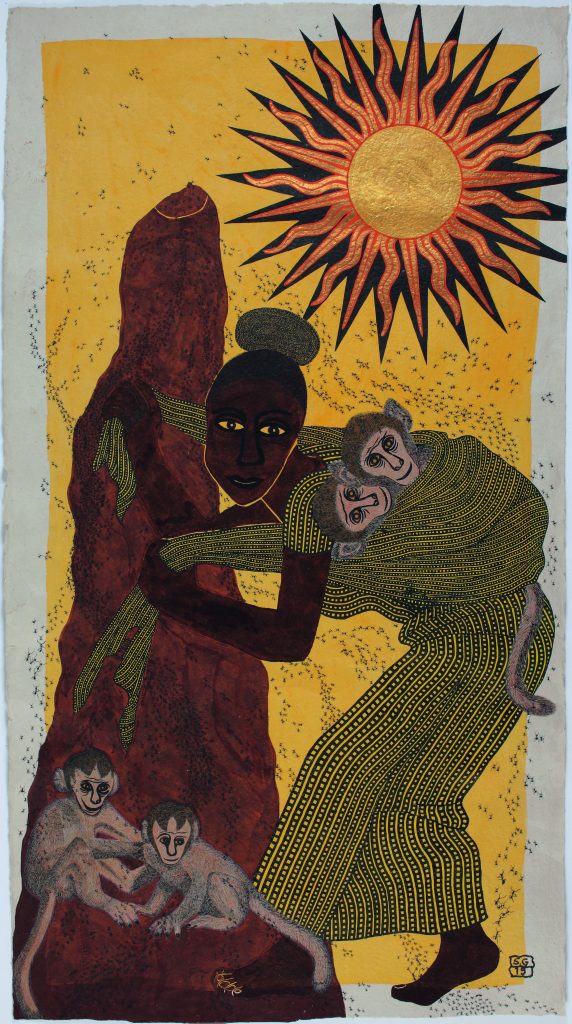
handmade paper, Collection of the
artist
Take Care of Each Other
-
What were the reasons behind your choice of the title of your work, “Take Care of Each Other”?
Actually, this title has two meanings. For one, it references “take care,” the phrase people use to say goodbye to each other with good intentions. Not only do you take care, but the world has become such an evil, cruel place, it may not be enough that you take care of yourself. All of us must take care, treat others nicely, and protect each other.
On the other hand, it makes an allusion by communicating directly to the viewer. The crying faces of women in the painting directly gaze toward the viewer and say, “Take Care of Each Other,” right at the viewer staring at them. It’s an ironic appeal, a wish to not be blind, deaf, and mute towards that pain.
Pursuit of Expression
-
What can you say about the dynamic that your figures of women provide for your paintings?
I always have interesting women in my life. They are the women I imagine, in fact all of them are me. They are my look, my laughter, my portraits… The fragility, courage, teasing and smiles of my women are the reflections of my emotions. I have always incorporated a pursuit of expression into my art. With time, these figures, my figures, have lived on. With my travels to Africa, they found new cycles, new stories. They underwent a transformation. You will see that change in this exhibition.
The Ability to Transform into Your Own Language
-
How did the pandemic affect you and your practice? The artistic community of this new world is seeking digital work… What are your thoughts on working with digital tools? Was it during the pandemic that you made digital work for the first time? How was this experience? Was it perhaps like a new language?
Like everyone else, I’m also influenced very much by the course of pandemic. The flow of life suddenly changed. At the same time, it tied many to their homes. Lifestyles, ways of working, and habits had to be abandoned. Of course everyone rushed to technological tools. During the preparation of this exhibition we too had to conduct some meetings online. Normally I travel often, I can’t stand still. So imprisonment at home felt very desperate. During the first months I couldn’t even go to my studio. However I tried to use the time spent at home as efficiently as possible. I did my exercises, meditated and practiced yoga at home. I watched many movies and documentaries. Read new books. I sailed. For two months, on the sea, I contemplated my exhibition. Loneliness both taught me and enabled me to see the truth.
It is very understandable that digital works in art have increased as technology advances. Art has always utilized present technical developments and the technology’s opportunities of its age. What is important is the ability to form an individualized vernacular, to have a soul, a feeling and an offering.
Two Video Works
Whatever the technique is, what is important is to transform this technique into your language. My primary tools are my hands, brushes and pencils, techniques we call traditional. When I was traveling to Africa, I had the idea to shoot a video and create a digital work. We set off with our equipment. We recorded over three hours of footage. Finally, we created the two video works you will see at the exhibition.
If I wasn’t satisfied with the material, I wouldn’t include a digital work in the exhibition. It doesn’t matter. But as soon as I saw the dancing Masai people, I felt that it could evolve into the video work I had in mind. I used video in this exhibition because I wanted to, in order to see the effect of establishing a different relationship.
Curator Öykü Özsoy on the Exhibition’s Context
Back to Mother Nature
-
Can you elaborate on the title “This Place We Call World”?
“This Place We Call World” aims to take a look at the world from the eyes of the artist while opening up her world to us. In that sense, it is an exhibition title operating on two axes: how does Gürbüz, who creates by combining the world we live in with her vocabulary of images, perceive the world? What does she tell us? How does she present to us stories of those we see and do not see? As we are face to face with striking, captivating works, she invites us to explore her world.
New Methods
Selma Gürbüz has shared with us her archive, which includes work from across her 35-year long artistic life. With an intense study on the archival materials, we determined the exhibition’s themes and selected the works that will be shown. The extraordinary period created by the pandemic is a period in which conventional living conditions have completely changed, and in which we have introduced and experienced new methods. At the same time, I can say that it led us to think more often about the world we live in and its future. We introduced themes related to this in the exhibition.
-
You say that “she describes human, nature and animal figures in an inseparable union in her works.” Can you expand on this statement a little more?
In the mysterious and colorful world created by Selma Gürbüz, symbols and stories about humanity, nature and our lives come to life.
The artist has a great love, passion and curiosity towards nature. The loveless, opportunistic interventions made into nature hurt her immensely, and she feels the need to escape from them. She desires to integrate with nature and feel that she is a part of it. In her work, she shares these experiences with us.
Bodies Blending With Plants
The sovereignty of the modern world, in which human and non-human beings are moving away from each other, collapses suddenly in Selma Gürbüz’s paintings. There is an emphasis on the return to Mother Nature , Gaia, remembering her nurturing and protective feminine existence and her power to produce. It is a meditation on our forgotten essence, the reality that we are a part of nature. The hybrid creatures, bodies blending with the plants that appear in the artist’s works belong to prehistoric myths. They are in parallel with the understandings of ancient narratives that destroy the hierarchical order between humans and non-humans to bring them together.
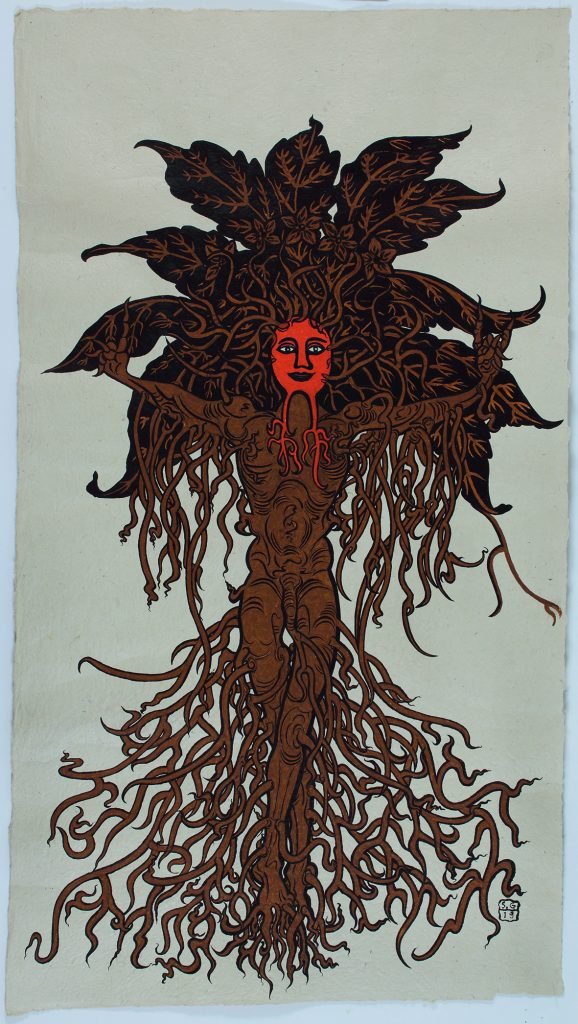
handmade paper, Collection of the artist.
Anatolian Legends
The animal-headed and human-bodied beings that we come across in Anatolian legends, Eastern and Western mythologies, Shamanism narratives, Iranian, Indian and Turkish miniatures, are the same that inspire Gürbüz. They are not freaks, but creations that symbolize being one and whole with nature.
The rigid boundaries between the two species that are created by modern life blur and melt into each other. Without alienation comes liberation. Within this emancipation, there is a desire to celebrate, dance, sing, and meditate. As we often see in the works of Gürbüz, there Is a desire for the detached roots to meet with the earth again, and be made complete and whole.
-
What context is the exhibition based on?
The exhibition focuses on Selma Gürbüz’s most recent unseen works, sharing the meticulously handled creations weaved with tales, myths and legends, independent of time and space. “This Place We Call World” is an exhibit that aims to grasp her artistic oeuvre spanning 35 years, through certain themes. Although we do not call it a retrospective, it is fair to say that it is the most comprehensive show of the artist shown under the roof of a museum in Turkey. The exhibition showcases more than 100 works which by the artist, using various tools of expression such as painting, installation, drawing, video and sculpture.
A Unique Color Scale
Selma Gürbüz, in her artistic practice, explores themes of history, tradition, mythology, nature and the subconscious. Throughout the years, with various different materials she manifests an artistic language, adding new dimensions to these themes. With her oil on canvas works, or ink on handmade paper that she has worked with since the 80’s, Gürbüz creates optical illusions and chiaroscuros. Her unique color scale gives life to symbols, figures, patterns and motifs, opening the door to an in-between realm of dream and reality.
The artist’s travels to different geographies are also the driving force behind the emergence of new narratives. She meticulously researches and observes different cultures, combining these influences with her own visual accumulation and imagination. Her paintings after her trip to Africa, shown for the first time in this exhibition, visualize the intersecting lives of humans and animals in the warm, generous and sometimes threatening nature of this region.
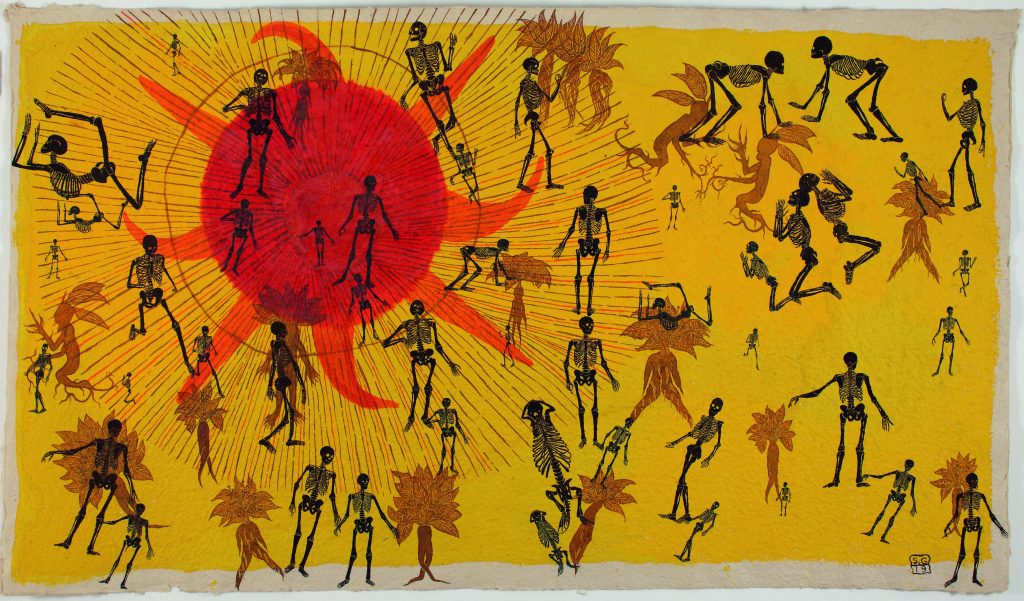
The Theme: Womanhood
Womanhood is another theme of Selma Gürbüz’s oeuvre. Her depictions of women are those who break social pressures and the roles imposed on them, undertaking internal journeys to discover their own nature, and seeing the spirit of nature as a part of their existence. Together, they portray the artist’s own transformation over time.
Selma Gürbüz skillfully brings together elements of both Eastern and Western culture; their subjects and techniques. The color black and the shadows that she identifies with this color have an important place in her artistic practice. The artist’s relationship with shadows develops as she delves into and reinterprets how the allegory of a shadow plays prominently in Turkish and Eastern cultures.
The artist, who created her first shadow play as an installation at the Gwangju Biennale in South Korea in 1995, animates the animal figures she made from paper pulp for this project and creates shadows with the figures that she projects onto the wall. Over the following years, shadow characters settle into Gürbüz’s two-dimensional works like old friends.
Humanity’s complicated relationship with life and death finds its place in Selma Gürbüz’s paintings. In her work, the artist defines life and death as cycles that complete each other. She reveals the contradictions between life and death, reality and the imaginary by combining her personal experiences with visual memory in these paintings.
A Visual Encyclopedia
Beyond its service as an exhibition, I would like to describe “This Place We Call World” as a visual encyclopedia. It has come into being as Selma Gürbüz’s art production grows more and more refined over the years. The artist offers her spirit of traveling between geographies, times and cultures, her thoughts on the subjects she has carefully collected, and a focus on people, nature and life, and asks us to reconsider. Although Selma Gürbüz’s works seem far from the reality of the world we live in, they actually tell us about life, the passage of time and the state of the people living within this cycle.
No Geographical Limits
-
What would you say about Selma Gürbüz’s place in local and global art history? How has the artist made a difference with her unique approach?
Selma Gürbüz combines and draws on unexpected links between elements of Eastern and Western cultures in her artistic practice. While drawing on influences from Iranian, Indian, and Turkish miniatures as well as the art of the Far East, she with also uses the elements of Western painting in her work. Like a time-traveler shifting between different geographies and cultures, she does not build her artistic production and intellectual practice under the sovereignty of a single geography. On the contrary, she establishes different relationships and narratives between them. There are no geographical limits for Gürbüz. She is interested in all artistic traditions and goes after the emotions that inspire her own work within these traditions. In all of her works, she has the ability to convey emotions we have not discovered yet about ourselves, humanity and the world we live in.
Selma Gürbüz: This Place We Call World”, can be viewed at Istanbul Modern until March 31, 2021.





